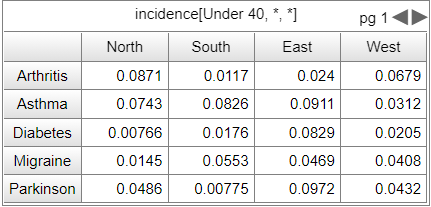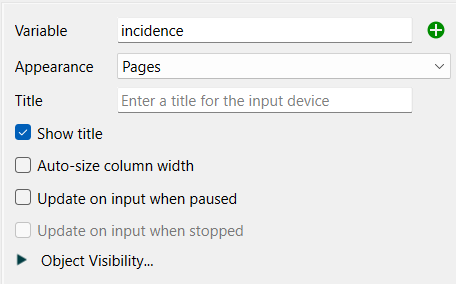
The array output is a specialization of the Numeric displays designed to work with arrays. It provides a mechanism for the interface user to see all values for an arrayed variable. The values appear as cells in a table. For arrays with more than 2 dimensions there will be a number of pages automatically created for the output. The last array dimension will be used for columns, the second last for rows, and earlier ones for pages.

Select Array Output ![]() by clicking on the dropdown next to the Numeric Display
by clicking on the dropdown next to the Numeric Display ![]() icon on the Interface Build toolbar, and click on the page at the location you want it to appear. After placing it, you can size it by dragging its sizing handles or using the Properties panel.
icon on the Interface Build toolbar, and click on the page at the location you want it to appear. After placing it, you can size it by dragging its sizing handles or using the Properties panel.
Note The array output tool will only appear on models that have arrays defined.
Note The array output does the entire array with a page for each 2 dimensional sub array. To manage specific sub arrays you will need to create different variables in the model.
The array input is intended to make it very easy tod isplay complete arrays. Therefore it has very few properties.

Variable specifies the variable you want to see the output for. This should be a variable name with no array dimensions specified. Use the ![]() to open the Find window to select, or simply type in the variable name.
to open the Find window to select, or simply type in the variable name.
Appearance sets the page selection type. The number of pages will be determined by the array dimension. See Pages Styles (Interface)for more discussion of the page selection types.
Title specifies the title that will appear at the top of the list of inputs. The title will be the same for every page. If left blank, the label for the current 2 dimension sub-array will be display (e.g. pop[1,1,*,*], pop[1,2,*,*] and so on).
Note For arrays of 3 or more dimensions (which require multiple pages) it is recommended that you leave the title blank.
Show Title, if checked will display the title. Otherwise the title will be left blank, though the geometry of the object will not change.
Set styles using the Styles ![]() tab as described in Styles Tab. In addition to position and size, you can specify the background color and, separately, the fonts for text and header text.
tab as described in Styles Tab. In addition to position and size, you can specify the background color and, separately, the fonts for text and header text.
Note that styles are the same for every page.